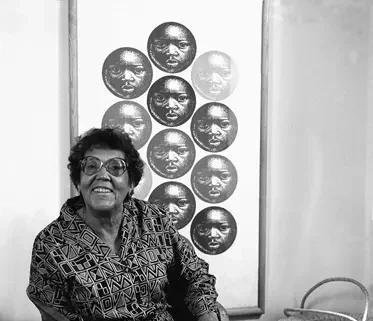Black Art Matters: Swann Auction Galleries Continues to Shed Light on Celebrated Black American Artists

Early in her career, Elizabeth Catlett was advised to “take as her subject what she knew best.” Most of her iconic sculptures after that featured Black American women and those from oppressed communities. Catlett’s awareness of the exploitation of Black women resulted from the many stories her mother told to her. These stories mainly were narrations of the realities of life in the slums and hardships faced by women in her family. Catlett herself was rejected from Carnegie Mellon University because of her skin color. She graduated instead from Dunbar High School in Washington and continued her studies at the University of Iowa.
Unlike most artists who shifted to abstract art after World War II, Elizabeth Catlett moved to Mexico in pursuit of meaningful social art. Her career flourished further when she started featuring political and human rights issues in her works. The American government restricted her ability to move to the United States because of her bold artwork and communist affiliations. Catlett became a Mexican citizen in 1962.

Only a handful of important stone sculptures by Catlett from the 1940s circulate in the auction market today. Head and Mother and Child are two of them. She created the Mother and Child sculpture during her final year at the University of Iowa. Catlett described her belief in her subjects: “Because I am a woman and know how a woman feels in body and mind, I sculpt, draw, and print women, generally black women.”

The upcoming African American Art auction, presented by Swann Auction Galleries, highlights a sculpture by Elizabeth Catlett (estimate: USD 150,000 – $250,000). It is a 35-inch carving of a young man’s head from the artist’s seminal 1940s period. Swann Auction Galleries, a pioneer in bringing Black American art to the forefront of the art industry, holds the 2019 auction record for Elizabeth Catlett. Swann Auction Galleries is also the only major auction house with a department dedicated to Black American art. The first Black American fine art sale was held in February of 2007. Before then, very few venues celebrated Black artists or established records for artists without a significant auction history.

Richmond Barthé was another renowned artist who battled racism to showcase Black American history through his works of art. Barthé, known for his realistic sculptures, was once barred from attending the New Orleans Art School because of his race. He enrolled at the Art Institute of Chicago instead. Over the years, he was recognized for his figurines that encapsulated the lives of Black people as seen on the streets or at dance halls. Critical and commercial success made Richmond Barthé one of the first Black American artists to develop a thriving career in New York.
A cast of Feral Benga, one of the most iconic works by Richmond Barthé, sold for a record $629,000 at a Swann Auction Galleries event in 2020. The upcoming sale of Black American art highlights another Feral Benga cast bronze sculpture by Barthé (estimate: $75,000 – $100,000). The piece, modeled in 1935, is part of a series of sculptures Barthé designed after meeting Folies Bergères dancer Benga during his first visit to Paris in 1934.

With modern and post-war paintings by artists including Noah Purifoy, Timothy Washington, and Hale Woodruff, Swann Auction Galleries will continue to celebrate Black American history through this sale. The auction showcases 234 lots of Black American art and will begin on October 7th, 2021, at 12:00 PM EDT. Visit Swann Auction Galleries for more information or to place a bid.










